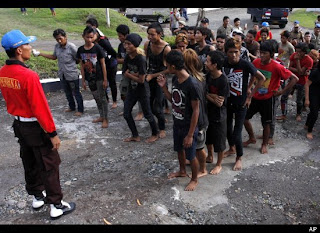Updated, 1:23 p.m. Sunday | In a tense showdown above the East River, the police arrested more than 700 demonstrators from the Occupy Wall Street protests who took to the roadway as they tried to cross the Brooklyn Bridge on Saturday afternoon.
The police said it was the marchers’ choice that led to the enforcement action.
“Protesters who used the Brooklyn Bridge walkway were not arrested,” Paul J. Browne, the chief spokesman for the New York Police Department, said. “Those who took over the Brooklyn-bound roadway, and impeded vehicle traffic, were arrested.”
But many protesters said they believed the police had tricked them, allowing them onto the bridge, and even escorting them partway across, only to trap them in orange netting after hundreds had entered.
“The cops watched and did nothing, indeed, seemed to guide us onto the roadway,” said Jesse A. Myerson, a media coordinator for Occupy Wall Street who marched but was not arrested.
A video on the YouTube page of a group called We Are Change shows some of the arrests.
Around 1 a.m., the first of the protesters held at the Midtown North Precinct on West 54th Street were released. They were met with cheers from about a half-dozen supporters who said they had been waiting as a show of solidarity since 6 p.m. for around 75 people they believed were held there. Every 10 to 15 minutes, they trickled out into a night far chillier than the afternoon on the bridge, each clutching several thin slips of paper — their summonses, for violations like disorderly conduct and blocking vehicular traffic. The first words many spoke made the group laugh: all variations on “I need a cigarette.”
David Gutkin, 24, a Ph.D. student in musicology at Columbia University, was among the first released. He said that after being corralled and arrested on the bridge, he was put into plastic handcuffs and moved to what appeared to be a Metropolitan Transportation Authority bus, along with dozens of other protesters, for over four hours. They headed first into Brooklyn and then to several locations in Manhattan before arriving at the 54th Street precinct.
Men and women had been held separately, two or three to a cell. A few said they had been zip-tied the entire time. “We sang ‘This Little Light of Mine,’ ” said Annie Day, 34, who when asked her profession said, “I’m a revolutionary.” Ms. Day was wearing laceless Converse sneakers: police had required the removal of all laces as well as her belt. She rethreaded them on the pavement while a man who identified himself as a lawyer took each newly freed person’s name.
None of the protesters interviewed knew if the bridge march was planned or a spontaneous decision by the crowd. But all insisted that the police had made no mention that the roadway was off limits. Ms. Day and several others said that police officers had walked beside the crowd until the group reached about midway, then without warning began to corral the protesters behind orange nets.
Sarah Maslin Nir for The New York TimesBrett Wolfson-Stofko, center, ran through a line of cheering supporters after being released from the Midtown South Precinct in Manhattan.
The scene outside the Midtown South Precinct on West 35th Street around 2 a.m. was far more jovial. Only about 15 of the rumored 57 people had been released, but about a dozen waiting supporters danced jigs in the street to keep warm. They snacked on pizza. One even drank Coors Light beer, stashing the empty bottles under a parked police van. When a fresh protester was released, he or she ran through a gantlet formed by the waiting group, like a football player bursting onto the field during the Super Bowl. “This is so much better than prison!” one cheered.
“It’s cold,” said Rebecca Solow, 27, rubbing her arms as she waited on the sidewalk, “but every time one is released, it warms you up.”
The march on the bridge had come to a head shortly after 4 p.m., as the 1,500 or so marchers reached the foot of the Brooklyn-bound car lanes of the bridge, just east of City Hall.
In their march north from Zuccotti Park in Lower Manhattan — headquarters for the last two weeks of a protest movement against what demonstrators call inequities in the economic system — they had stayed on the sidewalks, forming a long column of humanity penned in by officers on scooters.
Where the entrance to the bridge narrowed their path, some marchers, including organizers, stuck to the generally agreed-upon route and headed up onto the wooden walkway that runs between and about 15 feet above the bridge’s traffic lanes.
But about 20 others headed for the Brooklyn-bound roadway, said Christopher T. Dunn of the New York Civil Liberties Union, who accompanied the march. Some of them chanted “take the bridge.” They were met by a handful of high-level police supervisors, who blocked the way and announced repeatedly through bullhorns that the marchers were blocking the roadway and that if they continued to do so, they would be subject to arrest.
There were no physical barriers, though, and at one point, the marchers began walking up the roadway with the police commanders in front of them – seeming, from a distance, as if they were leading the way. The Chief of Department Joseph J. Esposito, and a horde of other white-shirted commanders, were among them.
Ozier Muhammad/The New York TimesPolice secured some protesters’ hands with plastic ties.
After allowing the protesters to walk about a third of the way to Brooklyn, the police then cut the marchers off and surrounded them with orange nets on both sides, trapping hundreds of people, said Mr. Dunn. As protesters at times chanted “white shirts, white shirts,” officers began making arrests, at one point plunging briefly into the crowd to grab a man.
The police said that those arrested were taken to several police stations and were being charged with disorderly conduct, at a minimum. A police spokesman said some protesters — mostly those without identification — were still “going through the system” late Sunday morning.
A freelance reporter for The New York Times, Natasha Lennard, was among those arrested. She was later released.
Mr. Dunn said only people at the very front could hear the warning, and he was concerned that those in the back “would have had no idea that it was not O.K. to walk on the roadway of the bridge.” Mr. Browne said that people who were in the rear of the crowd that may not have heard the warnings were not arrested and were free to leave.
Earlier in the afternoon, as many as 10 Department of Correction buses, big enough to hold 20 prisoners apiece, had been dispatched from Rikers Island in what one law enforcement official said was “a planned move on the protesters.”
Etan Ben-Ami, 56, a psychotherapist from Brooklyn who was up on the walkway, said that the police seemed to make a conscious decision to allow the protesters to claim the road. “They weren’t pushed back,” he said. “It seemed that they moved at the same time.”
Mr. Ben-Ami said he left the walkway and joined the crowd on the road. “It seemed completely permitted,” he said. “There wasn’t a single policeman saying ‘don’t do this’.”
He added: “We thought they were escorting us because they wanted us to be safe.” He left the bridge when he saw officers unrolling the nets as they prepared to make arrests. Many others who had been on the roadway were allowed to walk back down to Manhattan.
Mr. Browne said that the police did not trick the protesters into going onto the bridge.
“This was not a trap,” he said. “They were warned not to proceed.”
In related protests elsewhere in the country, 25 people were arrested in Boston for trespassing while protesting Bank of America’s foreclosure practices, according to Eddy Chrispin, a spokesman for the Boston Police Department. The protesters were on the grounds and blocking the entrance to the building, Mr. Chrispin said.
Mayor Michael R. Bloomberg, speaking briefly before marching in the Pulaski Day Parade in Manhattan on Sunday, also defended the police’s actions.
“The police did exactly what they were supposed to do,” the mayor said, noting that those who march without the city’s permission would continue to get summonses. “It’s very easy to get a permit,” he added.
As the morning wore on, Zuccotti Park had the hallmarks of Sundays the world over. There was brunch: someone had donated bagels and lox. There was the morning paper: protesters who had camped for the night read the self-published newspaper “The Occupied Wall Street Journal,” some snuggled the metallic blankets usually worn by marathon runners. One man brushed his teeth without water, standing up.
The scene was largely quiet, save a man in a fedora freestyle rapping with drummers in the east corner of the park. Many of those who had been arrested returned at about 3 a.m. to a heroes reception, said Rick DeVoe, 54, from East Hampton, Mass. They were sleeping in.
“It’s not always at a fever pitch,” Mr. DeVoe said. “It’s not easy sleeping out, it’s not easy going to jail.”
Quiet political discussions continued around the sleepers. One woman gave a pep talk to what looked like a new recruit. “It’s about taking down systems, it doesn’t matter what you’re protesting,” she said. “Just protest.”
Some tourists wandered in between the makeshift beds and volunteers sweeping up cigarette butts. A man visiting from Virginia and his 4-year-old son snapped photos, as did an elderly couple passing through.
Natasha Lennard, William K. Rashbaum and Elizabeth A. Harris contributed reporting.
 Indonesia Punk Crackdown Leaves Youths Unchanged
Indonesia Punk Crackdown Leaves Youths Unchanged 









